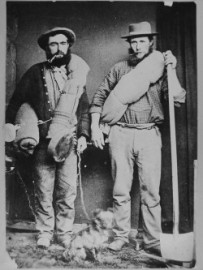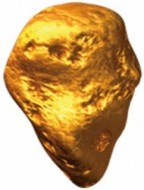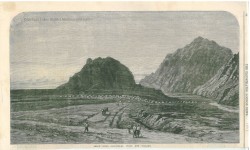
For Students - Gold, Gold, Gold!
'Many millions of years ago, our country was born. The plates of the earth pushed and heaved New Zealand up from the sea, a small  island far from the rest of the world. The earth groaned and boiled, pushing the Southern Alps into the sky, and forcing boiling water into the cracks of the rocks. As the water cooled, it left pounamu in the mountains and golden treasures hidden in the quartz.
island far from the rest of the world. The earth groaned and boiled, pushing the Southern Alps into the sky, and forcing boiling water into the cracks of the rocks. As the water cooled, it left pounamu in the mountains and golden treasures hidden in the quartz.
Then came the ice. Grinding, cracking, ploughing through. Digging the lakes, shaping the valleys, carving the Wakatipu and releasing the gold. Finally nature left a special kingdom of birds to rule New Zealand, undisturbed by man. That is how our country began.'
- Why are people so interested in gold? Create a mind map of all the reasons why people came hunting for gold.
- What are the uses of gold? You could work in groups and have a competition to see who can make the longest list. When you visit the Museum the educators will ask you about some of the uses of gold - so make sure you remember them!
www.teara.govt.nz/EarthSeaAndSky/MineralResources/GoldAndGoldMining/en
www.otago.ac.nz/geology/features/gold/otago.htm
In 1862 Jack Tewa discovered gold in the Arrow River. By the end of October there were around 1500 miners camped down along the shores of the Arrow River.
Lots of miners wrote letters to their friends and families to encourage them to come to the Wakatipu goldfields:
Dear Jack,
I am making my pile fast. 100 pounds a week. This is the richest river in the world. I walk up to my waist in water, put down the shovel and sometimes bring up 5 or 6 ounces....
Miners poured into Arrowtown from all around the world. They arrived at Port Chalmers in Dunedin by boat and had to travel inland to the Central Otago goldfields.
- How do you think the miners travelled from Port Chalmers in Dunedin to Arrowtown?
Food was scarce when the miners arrived on the Wakatipu goldfields.
'A man rushed into our hut, when George was in the act of kneading the dough. He seized the lump of dough and devoured it. He had hollowed cheeks, staring eyeballs and ragged clothes - all evidence of a fast, rough and toilsome journey. Having satisfied his appetite he told us he had been without food for five days.'
Extracted from Alfred H. Duncan’s The Wakatipians. First published 1888.
'Because it is so difficult to access the district, provisions were extremely scarce and dear. I often had 200 to 400 men waiting for my whaleboat to come up from Kingston to get a few pounds of flour each. So hard set were some of them that they would then and there boil the flour in 'billies' not being able to wait for baking.'
Extracted from Vincent Pyke, Early Gold Discoveries in Otago, 1887.
Eat like a goldminer for a day
Do you think you could eat the food of a miner?
Ask your teacher if your class is allowed to eat like a miner for a day.
Breakfast - Porridge (made with water not milk) and a little bit of brown sugar.
Morning Tea - Apples (fresh or dried)
Lunch - Damper with mutton or bacon. You could add other supplies to your damper - cheese, canned sardines, pickled onions. Think of preserved food that was available at the time.
Damper Recipe - 3 parts water to 10 parts flour with a pinch of salt.
Cooking - you can either make little loaves and place on an oven tray or you could try and cook it authentically. Wind your damper mixture over a stick and place it over campfire embers. Don't worry if you burn your damper - hungry miners eat anything!
Afternoon Tea - Damper. Maybe you could treat yourself by filling it with a bit of homemade butter and jam - it's scrumptious!
Dinner - Damper and mutton. You could have a handful of currants or raisins as a treat.
To Drink - Tea or water. Perhaps you might have a ginger beer and pretend you are socialising at a grog shanty.

